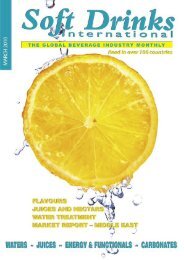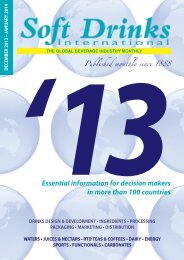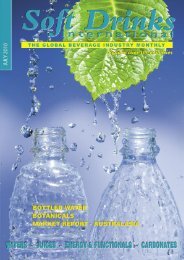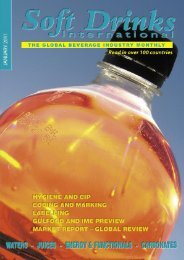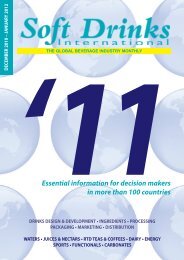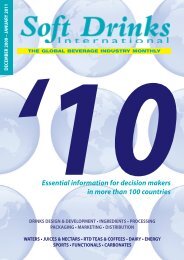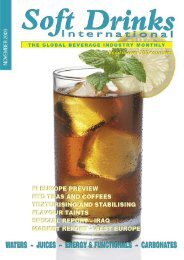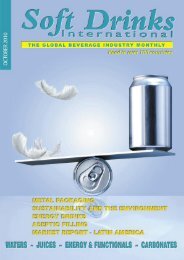Palatinose - Soft Drinks International
Palatinose - Soft Drinks International
Palatinose - Soft Drinks International
You also want an ePaper? Increase the reach of your titles
YUMPU automatically turns print PDFs into web optimized ePapers that Google loves.
40 PACKAGInG<br />
<strong>Soft</strong> <strong>Drinks</strong> <strong>International</strong> – February 2011<br />
Single-file<br />
accumulation<br />
THE new AQ-File conveyor from Sidel can<br />
be used for the accumulation of a wide<br />
range of containers, both filled and empty,<br />
regardless of the material used, particularly<br />
those with complex shapes that are not suitable<br />
for mass accumulation. It can be used<br />
on bottling lines with speeds of less than<br />
30,000 bottles per hour.<br />
AQ-File was developed with a simple<br />
operating principle and an open design. It is<br />
composed of a horizontal chain that winds<br />
around a wheel mounted on a mobile carriage.<br />
Accumulation is done by varying the<br />
length of the accumulation chain; the carriage<br />
moves back to create accumulation<br />
and advances to discharge the containers.<br />
The simple design, based on the principle<br />
for a standard single-file conveyor, offers<br />
optimal accessibility for all of its components<br />
at chest height, in contrast with spiral or<br />
shielded solutions. It also guarantees easy,<br />
limited maintenance. In addition, AQ-File<br />
retains all of the qualities associated with single-file<br />
accumulation: respect for container<br />
orientation and FIFO conveying (First In First<br />
Out).<br />
Suitable for multi-format applications, the<br />
conveyor handles format changeovers with<br />
Brazil drives<br />
stretch pallet<br />
A NEW report from industry consultants,<br />
AMI Consulting, points to South America as<br />
one of the fastest growing and most<br />
dynamic markets for pallet stretch film in the<br />
world. In spite of the global financial crisis<br />
and recession, demand for pallet stretch film<br />
continued to advance in the region between<br />
2004 and 2009 by over 10% per year and is<br />
forecast to grow by almost 8% per year to<br />
2014. Within the South American market<br />
Brazil accounts for 50% of the regional<br />
demand.<br />
In Brazil pallet stretch film production has<br />
grown over the past five years by 30% per<br />
annum and is forecast to grow by 15% per<br />
annum to 2014. During the same period, it<br />
is forecast that Brazil’s imports of pallet<br />
stretch film will reduce to virtually zero.<br />
Argentina is the next largest South American<br />
market in terms of demand, but at<br />
approximately 23,000 tonnes accounts for<br />
only 11% of the regional consumption.<br />
In comparison, the more mature markets<br />
of North America and Europe will see<br />
A simple, yet flexible design.<br />
minimal adjustment. Sidel says that due to its<br />
variable capacity and speeds, it provides<br />
great flexibility of use in managing accumulation<br />
times as a function of production characteristics.<br />
It can be easily integrated into all existing<br />
lines, and it interfaces with any single-file<br />
conveyor.<br />
lower levels of tonnage growth to 2014.<br />
Demand is forecast to increase by less than<br />
2% per year in the US and Canada as, even<br />
with economic recovery, there is significant<br />
emphasis being put on downgauging of films,<br />
not only hand films but also machine films,<br />
resulting in tonnage growth that does not<br />
mirror the increase in number of pallets<br />
wrapped.<br />
In Western Europe there is a similar situation<br />
to that seen in the US with emphasis<br />
on downgauging, particularly in the hand film<br />
sector, and the increasing use of prestretched<br />
films which significantly reduces<br />
the weight of film used to wrap a pallet.<br />
Growth in Central Europe, which is less well<br />
developed, is forecast at 5% per year while<br />
growth in Eastern Europe is forecast at 6%<br />
per year, giving a European total growth rate<br />
close to 3% per year to 2014.<br />
www.softdrinksinternational.com<br />
In brief…<br />
● Crown Bevcan Europe and Middle East<br />
was awarded overall Can of the Year winner<br />
at the 2010 Can of the Year Awards event.<br />
The company also gained a Gold Award for<br />
innovation in the Ends, Caps, and Closures<br />
category. Both accolades were for its full<br />
aperture end technology, first available for<br />
pressurised products. The entire lid can be<br />
removed, turning the can itself into a drinking<br />
cup and providing a new way to enjoy<br />
beverages at large events where traditional<br />
cans and glass bottles are prohibited. It also<br />
eliminates the need for pouring drinks into<br />
plastic cups, streamlining the serving<br />
process.<br />
● The results of work undertaken by the<br />
UK's Campden BRI into the costs incurred<br />
by companies when they change food and<br />
drink labels has been published by Defra<br />
(Department of the Environment and Rural<br />
Affairs). The research resulted in some interesting<br />
findings, as John Hammond, Head of<br />
Campden BRI's Information and Legislation<br />
Department, explained: “Developing a<br />
'Framework for Assessing the Costs of<br />
Labelling Changes' in the UK found that the<br />
costs of labelling changes per stock keeping<br />
unit were substantially greater than those<br />
that have been reported previously. Commercial<br />
factors are the cause of most label<br />
changes; those prompted by regulatory<br />
requirements accounted for a relatively<br />
small proportion.”<br />
The work drew on Campden BRI's unrivalled<br />
expertise in food labelling and helps<br />
to underline the importance of ensuring that<br />
labels are prepared right first time.<br />
● Rexam has converted both lines at its<br />
Egyptian beverage can plant from steel to<br />
aluminium and increased its production<br />
capacity in order to meet customer needs<br />
in the region. The company reports that<br />
customers have shown a growing preference<br />
for aluminium and the conversion to<br />
aluminium will help them clearly differentiate<br />
their brands with the wider variety of<br />
finishes and graphics that aluminium cans<br />
enable. Rexam Egypt now has an annual<br />
capacity of around 1.7 billion cans.<br />
● The Italian PET manufacturer SIAPI has<br />
opened an office in Moscow. Two years ago<br />
the company invested in North Africa and<br />
North America to target the water and<br />
beverage container market. With the<br />
Moscow opening SIAPI has shown its commitment<br />
to its established customers in<br />
Russia and CIS countries with a dedicated<br />
sales and after-sales service organisation.






